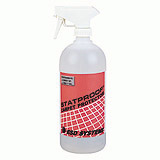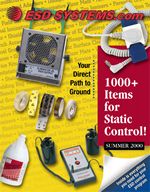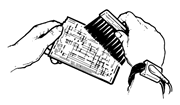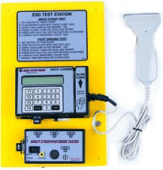 |
| ESD Technical e-Newsletter |
|

|
Nov/Dec 2000
Issue 10, Volume 3
|
|
Triboelectric Generation: Getting Charged
| |
Have you ever received an unexpected static shock? It's a nice brisk day as you park your car and slide out of the driver's seat only to experience a significant electric shock as you grab the metal door handle. What happened? Why did you just get zapped? First, you got charged up with static electricity when sliding out of the driver's seat. This is a common phenomenon experienced every time when two materials come into contact and then separate, and is known as triboelectric charging. Second, when your body's skin, being a fairly good electrical conductor, came into contact with a very good conductor (metal door) your body's accumulated charge is quickly discharged (brought to the same potential as the door) which resulted in an electric shock.
Triboelectric charging or tribocharging for short is the most frequently occurring phenomenon for charging materials and yet one of the least understood. Tribocharging affects us every day whenever we move ourselves or other materials. This phenomenon is especially a concern to the electronics industry. Static charge build-up can lead to detrimental effects to semiconductor devices upon discharge. Electrostatic discharge (ESD) can cause electronic upsets or latent and/or catastrophic failures.
To control ESD events, it is highly desirable to use materials that are low tribocharging (antistatic) as well as dissipative for the use of handling, packaging, and storing ESD susceptible electronic devices. Understanding triboelectrification may help to choose or design materials that will minimize tribocharging in ESD protected areas when working on ESD susceptible products.
II Triboelectric Series
When two materials with neutrally charged surfaces come into contact (< 4 Å [an angstrom (Å) is 10-10 meters]) and then separate, the materials will have undergone tribocharging and now be at a non-neutral surface charge level. The level and polarity of this newly acquired surface charge is at is dependent on several factors, but can be relatively answered by viewing the triboelectric series chart [figure 1].
A material such as glass that comes into contact with a vinyl material will acquire a more positive charge because it is near the 'more positive' position in the triboelectric series chart relative to the position of vinyl. Alternately, the vinyl will acquire a more negative charge following the same logic. The fact that these two materials are far apart from each other in the series will typically result in a larger charge level generated then if the glass came into contact with, say aluminum.

The above list is combined from references: [4, 5, and 6]
FIGURE 1
The triboelectric series is a loose ranking of a material's polarity when triboelectrically charged with a given material. The ranking of a material may easily change position in the series depending on several factors such as surface roughness, force of contact, work function, charge backflow, charge breakdown (of air), etc. These variables, which affect the magnitude of the charge generate, only add to the confusion of understanding the tribocharging mechanism and make the triboelectric series chart a relative comparison of materials and not an exact science.
III THEORY
Click Here to Link to our White Paper to read about the Theory behind Triboelectric Generation
IV EXAMPLES
Standard cellulose tape is a good example of a material that has a strong surface adhesion and consequential large surface area contact typically resulting in large charge imbalance during unwind or removal after being applied. During unwind the contact and separation of the tape to itself is called "contact charging" or "electrification by contact" and has little to do with friction (or rubbing). Another contribution to the large imbalance of the tape during unwind is the difference in materials. The tape film is cellulose and the adhesive may be rubber based. The two are spaced far enough apart in the Triboelectric Series to result in defined polarities, see figure 1. The rubber adhesive will acquire a more positive charge and the cellulose will acquire a more negative charge due to the difference in their work functions as illustrated below [figure 3]. Voltages well over 20 kV are easily measured from this type of tape, particularly at low relative humidity (RH).

Illustration of tribocharging during unwinding of standard cellulose tape
Figure 3
Another good illustration of tribocharging is to use a pair of ESD training paddles, see figure 4. One paddle is typically aluminum and the other acrylic, which are well separated in the Triboelectric Series. When the bottoms of both paddles are brought together and rotated (frictional heating) then separated, an electrical charge imbalance will exist between the two plates. Using a static field meter or charged plate analyzer you can measure several kilovolts on each paddle. As you can deduce from using the chart the resulting electric field (charge imbalance) on the aluminum paddle tends to be more positive and the acrylic tends to be more negative.

Example of ESD training paddles
(Aluminum paddle on the left, Acrylic on the right)
Figure 4
The fact that one paddle is very conductive and the other very insulative helps to illustrate the types of materials that may become charged in your ESD protected work area. Even though a surface may be conductive, it still becomes charged through triboelectric generation. Only when a conductive surface is tied to ground or other reference point, will it not be a threat by holding a charge imbalance. Controlling charge imbalance is important in ESD control. Conductors can be grounded, but insulators must be controlled by other methods.
V SOLUTIONS
When designing an ESD control program, in addition to storing and transporting ESD susceptible products in static discharge shielding materials outside and ESD protected area, there are two simple rules relative to dealing with charging problems. One is to ground all conductors, the other is to either remove or control all insulative charge generators (insulators). Grounding can easily be accomplished with various ESD control products [5]. In lieu of abstaining from the use of non-conductive charge generators, controlling them may be essential to the program. Controlling process essential insulators and may require the use of ionization or surface treatment with a topical antistat solution or spray. Neutralizing of charged objects is accomplished by using a balanced output air ionizer. The target is flooded with a multitude of positive and negative air ions which result in a near zero voltage level relative to ground on the charged surface after just a few seconds of exposure (decay time). The decay time is depending on several factors such as surface proximity to the ionization source, surface area, surface capacitance, level of charge imbalance, etc.
CONCLUSION
Understanding how materials interact with each other during the triboelectric process can help in the design of a control program that tries to minimize charge imbalance caused by this phenomenon.
Choosing materials that are either close to each other in (work function) the triboelectric series or antistatic (low charging) will help to minimize potential charge imbalances in an ESD protected work area.
Reproduced with Permission, EE-Evaluation Engineering, November, 2000
Referenced Paper:
Triboelectric Generation: Getting Charged
|
|
|
|
|
|
Static Dissipative
Binder Covers
 Binder Cover, 1" and 2" Spine Widths
Binder Cover, 1" and 2" Spine Widths
- 12 mil thickness, durable
- Clear, so won't obscure binder colors and markings
- antistatic (low charging)
- Static dissipative, so if charged will neutralize charge away when grounded
Buy Now  Tech Info
Tech Info 
|
|
|
|
Try this on your car seats!
Statproof® Carpet Protector

- Reduces the generation and build-up of static charges on carpeting and fabric chairs
- Provides excellent dry soil and stain resistance
- Can be applied to fabric chairs, carpet and other fiber materials
- Water based, easy to apply
- Trigger spray quart makes product easy to apply to small carpet areas and fabric chairs
- Coverage: 1,200 sq ft per gallon of concentrate, 25 sq ft per ready-to-use quart
Buy Now  Tech Info
Tech Info 
|
|
|
|
If you'd like a printed catalog, request one from our on-line catalog request form by clicking here.
You can also visit our on-line catalog 24/7 by clicking here.

|
|
|
|
Product document support includes a technical brief, drawing or bulletin. These are referenced within our on-line catalog as well as listed in our web site.

|
|
|
Antistatic and Dissipative Brushes

Our antistatic brushes are made from low charging materials and natural materials that are near neutral on the triboelectric chart. They neither give nor take electrons and, therefore, remain essentially electrically neutral. There can, however, be a slight charge created. In extreme voltage sensitive applications, these brushes should be used only in a liquid environment.
Item # 34118 & 34120 dissipative brushes have a surface resistivity of 105 - 1011 ohms, a higher resistivity than the conductive brushes, but sufficiently conductive to preclude any static build up in the brush. These are excellent tools to use in removing any static charge that will result in the adhesion of particles, such as dust, to an object. Frequent use of these brushes will keep electrostatic charges from building up on your products. Please use these brushes with a wrist strap or other mechanism to provide a path to ground for safety.
Buy Now  Tech Info
Tech Info 
|
|
|
Data Logger Test Station

New!
Data Logger Test Station Automatic logging of ESD test results from wrist strap and foot grounder. Connects to almost any PC using a serial port. Software Included.
Click Here to View Catalog
- Test Station connects to almost any PC using a serial port and standard modular phone cord
- Plug-in installation, no special interface cards required
- Output data can be sorted in various ways
- View and print reports in standard Windowstm format
- Easy to comply with ISO 9000 requirements and audits
- Saves hours of supervisor's time collecting data
- With the proper cable connections, up to 32 can be daisy-chained to one PC!
Buy Now  Tech Info
Tech Info 
|
|
|
|
|
EtroniX (Nepcon West) Click here for more information
|
| When: | Feb 27 - Mar 1, 2001 |
| Where: | Anaheim Convention Center, Anaheim, CA, USA | | What: | EtroniX features a family of industry related events - covering design, e-manufacturing, advanced packaging, production, test and more - all under one roof. |
| Why: | Visit us at our Booth, # T-2249 |
|
|
|
|
|
Q63: After going through the MIL-883 model, we discovered a different situation in which a shield device can be destroyed by ESD when it is removed from that environment. I ask if you agree. Also I am looking for references that state the leads need to be shorted when kept in an ESD bag for the protection to work! - Anonymous, Milpitas, CA see ANSWER 63
Q204: 1. What is the difference between static dissipative and conductive, as used in ESD floors for example?
2. What is the difference between ant-static and static dissipative, as used in gloves? - Elaine, Refraction Technology, Dallas, TX see ANSWER 204
Q403: My company is an OEM in the packaging industry We currently produce a machine which is p.c. controlled. We have noticed that the p.c. malfunctions due to an ESD event. The static build up occurs in the conveyor system as we drag a nylon conveyor belt across a polycarbonate support screen. There are additional problem areas along the conveyor where rubber rollers pinch the belt to drive it along creating a peeling action. I have used a static measuring device which verifies my concerns. I would like to suppress the electrical disturbance resulting from the ESD before it reaches the p.c. We are using a line filter and surge suppressor already but they don't seem to help the situation. The ESD disturbance is very brief (around 15 microseconds) but powerful. Is there any kind of filter or suppression device to control this type of transient? I understand that controlling the source of the ESD is another option but I'd like to explore any possible filtering first! -Anonymous see ANSWER 403
|
|
|
|
NOTE:
If you haven't already done so, downloading Acrobat Reader is highly recommended as most of our Technical Literature is in an electronic form known as portable document files (PDF files). These can be e-mailed or downloaded from our website, however you'll need Adobe Acrobat Reader to view them.
The good news is that this program is free. Adobe Acrobat can be downloaded from Adobe's website. The file is over 3 megs, so be sure you have the capacity to receive that large a file.
|
|
|
|
|
|
How to Economically remove Tribocharging Problems:
One of many ESD Control problems to pay attention to are charge generators in an ESD Safe area. The first level of control is abstinence of these charge generators, but those necessary or unremovable from within an ESD Protected Area should be controlled. The two main types of control are topical treatments or air ionization. The most economical control involves topical treatments such as for hard surfaces or fabric materials.
Reztoretm Topical Antistat Antistatic spray solution for almost any (hard) surface keeps triboelectric charges well below 200 volts per EIA-625. Its hard coat formula offers protection that lasts four times as long as the other leading brands. Reztoretm leaves a static dissipative and low charging surface layer to provide a safe path to ground. It is non-toxic and safe to use.
Statproof® Carpet and Fabric Protector Reduces the generation and build-up of static charges on fabric materials such as on carpeting and fabric chairs. It provides excellent dry soil and stain resistance and can be applied to fabric chairs, carpet and other fiber materials. It is water based and has a trigger spray making it easy to apply to small carpet areas and fabric chairs.
|
|
|
|
|
|
|
This is a free monthly eNewsletter, which specializes on issues in electrostatic control in the semiconductor/electronics workplace and is best viewed while connected to the Internet.
Let us know what you think. Tell us what you would like to see in future issues. Want to contribute articles or other related information to our Newsletter? If you have any comments, suggestions or feedback about this eNewsletter, please send them directly to the editor@esdsystems.com, thanks.
|
|
|
Copyright © 2000 ESD Systems.com. All rights reserved.
|
|